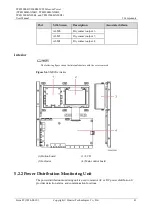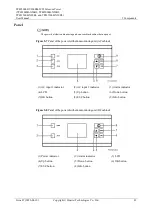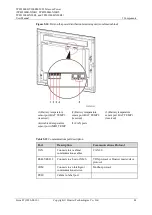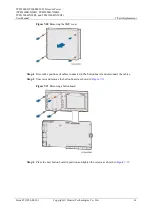
TP482000B V300R002C03 Telecom Power
(TP482000B-N20B1, TP482000B-N20B2,
TP481200B-N20B1, and TP481200B-N20B2)
User Manual
6 Routine Maintenance
Issue 07 (2020-04-10)
Copyright © Huawei Technologies Co., Ltd.
49
No.
Maintenance Item
If...
Then...
3
Check for AC input
undervoltage.
AC input power cables have
a large voltage drop.
AC input power cables are
in poor contact.
The mains voltage is too
low.
1.
Replace AC input power
cables with shorter or thicker
cables.
2.
Connect AC input power
cables securely.
3.
Provide the voltage data to
the power supplier.
4
Check for AC input overvoltage. The mains voltage is too high.
Provide the voltage data to the
power supplier.
5
Check whether the AC input
voltage is open-phase.
AC input power cables are
in poor contact,
short-circuited, or damaged.
The mains supply has failed.
1.
Check and rectify the cables.
2.
Provide the open-phase data
to the power supplier.
6
Check whether a DC output
circuit breaker is OFF and a fuse
is blown.
Load overcurrent occurs.
Load short-circuit occurs.
Rectify any overcurrent or short
circuit. Turn on the circuit
breaker or replace the fuse.
7
Check for DC busbar
overvoltage.
A rectifier is abnormal.
Replace the abnormal rectifier.
8
Check for DC busbar
undervoltage.
The AC power supply has
failed.
The system is overloaded.
A rectifier is abnormal.
1.
Resume the AC power
supply.
2.
Check the load status and
rectify faults if any.
3.
Replace the abnormal
rectifier.
9
Check whether the temperature
of a DC busbar working at room
temperature exceeds 95°C.
The DC busbar is loose or in
poor contact.
The system is overloaded.
1.
Check and secure cabinet
busbar connections.
2.
Check the load status and
rectify faults if any.
6.3 Rectifier
Table 6-3
Rectifier maintenance checklist
No.
Check Item
If...
Then...
1
Check the green indicator status
(normal: steady on).
Off:
There is no AC input.
The rectifier is faulty.
1.
Check the rectifier AC input.
2.
Replace the rectifier.
2
Check the yellow indicator status
(normal: off).
Steady on:
The rectifier generates an
alarm for power limiting due
to ambient overtemperature.
The rectifier has shut down
as a protective measure
1.
Check the ambient
temperature status, and clean
the cabinet air channel.
2.
Rectify faults in the indoor
temperature control system.
3.
Check the AC input voltage.
















































